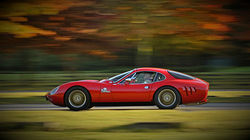
1961-2011 Paulussen Beradino

All photography work is copyrighted by the author & Johannes P. Paulussen,please don't download and publish these pictures in the internet without my permission! Larger high quality pictures is available up on request! Vasileios Papaidis 2015 © All Rights Reserved
Never heard of a Paulussen Beradino? That's because there's only one, and that took 50 years to finish.
This dream car, built by Johannes P. Paulussen began in 1961 a project, built because he really wanted a supercar like a Lamborghini Miura, Ferrari GTO or Ford GT40, but didn't have the money to build one. It was registered in 1974 and driven on the road, but other things in life got more important and the car was shelved. Now, in 2011 it is - fingers crossed - complete.Many visitors to the Concours d'Elegance of Classic Days, on the peninsula directly Orangerie at Schloss Dyck in Germany, stopped to at the curvy fire-red coupé. "What's that?"," It looks hot.","Is it a GTO?" or simply "Madness" were apparently some of the spontaneous reactions of people who saw this little beauty.It was imagined, conceived, drawn, designed, shaped and built by him when a student of automotive engineering and later as a vocational teacher.
His father, a master carpenter, at some point was apparently fed up with his son's fantasies and eventually ended the discussion by saying that if you really want a supercar, then you have to build it himself. With most people this would probably have been the end of such pinings, but not Paulssen. Once he started his studies in Automotive Technology he put pen to paper. Now you have to remember this was in a time before computers and CAD/CAM software; when everything was drawn and drafted to precise calculations, and Paulssen was not a person to rush things at the expense of quality. Of course, the rigours of studies and life in general are bound to get in the way and the years passed, but the dream survived - and so did the project. The avid student made a 1:10-plaster model, and later he built a 1:1 'male' mould, from wood and plaster (that weighed all of 500lbs), so from one of the many 'female' fibreglass moulds Paulussen made, he then spent weeks laminating the definitive body shell with fibreglass mat and polyester resin. Incidentally, the idea of using the then-relatively newfangled GRP material came through a now-famous designer; "Luigi Colani was (one of) the first to make a fibreglass body.
At that time he was still relatively unknown," says Paulussen, who had read about him in the 1960s, in an article in a specialist hobby magazine. Now having taken care of the body, Paulussen turned his attention to the matters of of a suitable chassis and powertrain. He was in constant contact with the TÜV experts, as the car would have to pass their ultra-strict road car reguations if the car was ever to turn a wheel legally. "Without that, the car would never have happened." states Paulusson. So with that in mind and in the interests of reliability, the choice of engine was a 2.0 Porsche flat-six, which produces 110bhp. The chassis consists of elements of Porsche and VW Beetle: "braking, steering and electrics are from the front of the Porsche 356, a design not far removed from it's Beetle origins, with the rear being the transaxle from the aforementioned 911.
The Paulussen-designed and built chassis is made from 40x100 mm square tubing with a wall thickness of 3mm; very stable, as well as TÜV-friendly. But he demanded an additional subframe for the Porsche engine - no problem for the talented Paulussen.In the following 15 years, Paulussen drove about 8,500 miles before the engine developed an oil leak and a loss of power; the engine would need a rebuild. The car was pushed into his garage - and the doors were shut. For 20 years. "The Beradino fell into a deep sleep," admits Paulussen. Until 2009 the Beradino sat, biding its time and its creator's attention. And with Paulusson's retirement came the spark needed to bring the car back to life. Paulussen went back over the plans for his dream car from scratch, and with renewed enthusiasm worked from morning to night on the car."Its taken another 3,000 man hours." says Paulussen. Always with an eye for detail, parts of the car have been updated. "The headlights are from the New Mini, the mirrors are modified Porsche 993 items, the front indicators Golf MKVI." Never afraid to to make changes to his baby, its no wonder that Paulussen gave his car the nickname "the living project". In his first appearance after restoration and repainting it - RAL color 3000 flame red - the Beradino won an award for best in prototype class at Castle Classic Days 2011 Concours d'Elegance.
Photo Gallery




















